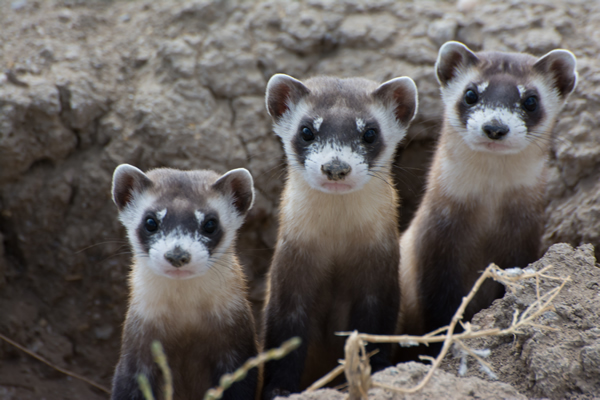Black-Footed Ferret

WESTERN GRASSLAND SPECIES:
Black-Footed Ferret (Mustela nigripes)
Background
The Great Plains and desert grasslands once covered more than 500 million acres, stretching from Canada and the United States into Mexico. Nearly 200 species of wildlife use this immense sea of grass in 11 different states (parts of Arizona, Colorado, Kansas, Montana, Nebraska, New Mexico, North Dakota, Oklahoma, South Dakota, Texas and Wyoming) within the United States.
Although these grassland ecosystems provide habitat for many species of wildlife, another primary function is to slow water runoff and allow for aquifer recharge. Aquifers are used for municipal drinking water, energy and industrial development and agricultural crop irrigation. However, due to a plethora of impacts, threats and stressors identified by states within their State Widlife Action Plans (SWAPs), such as control efforts, habitat loss due to conversion of grassland to crops, introduction of exotic diseases, habitat fragmentation due to development, urbanization, the grassland landscape has been greatly fragmented and reduced from historical estimates. Elimination of prairie dogs in many areas has exacerbated the losses, with consequent impacts on black-footed ferret that led to its imperilment (and, until 1981, its apparent extinction).
Prairie dogs are keystone species in the western grasslands, which means that other grassland species have an important component of their life cycle occurring in prairie dog towns. This includes the black-footed ferret, which is almost exclusively dependent on prairie dogs for food and their burrow complexes for shelter. Thus, by enabling purposeful management (targeted conservation) of prairie dogs, the states and their federal and tribal partners can effectively address grassland conservation needs, reducing imperilment of a variety of grasslands species and facilitating recovery of the endangered BFF.
The greatest challenge to conserving grassland ecosystems is maintaining prairie dog populations on the landscape. Massive poisoning campaigns to eradicate prairie dogs, exacerbated since the early to mid-1900s by outbreaks of plague, an exotic disease to which prairie dogs and black-footed ferrets are especially susceptible, left huge expanses of vacant dog towns. Local extirpations of prairie dogs increased as well, due to stochastic factors to which small, isolated populations are susceptible. Whether plague preceded poisoning or poisoning preceded plague, the result was the same: prairie dog extirpations and grassland degradation. Elimination of black-footed ferrets was simply collateral damage. And now, plague is slowly moving easterly, beyond the 100th Meridian, which, until now, has been known as “The Plague Line.” Although prairie dogs (and black-footed ferrets) are western species, a host of small rodents replace them in the east.
WAFWA and State Member Contributions to Black-footed Ferret Recovery
In the 1990s, thanks in part from funding provided by WAFWA, USGS began research on development and testing of a plague vaccine for prairie dogs that could be delivered via oral baits. The current method to manage plague, i.e. dusting with insecticides, in prairie dog colonies is effective but is labor intensive and not cost-feasible across expansive dog towns. An oral vaccine against plague that could be broadcast via plane or ATV in the form of baits would provide wildlife managers with a crucial management tool. The Black-footed Ferret Recovery Implementation Team (BFFRIT) Executive Committee is conducting a project to test, and (if proven effective) eventually implement, an experimental sylvatic plague vaccine (SPV) program for prairie dogs (Cynomys spp.). It involves 25 collaborating state, federal and tribal agencies and nongovernmental organizations in testing the vaccine at 29 sites on public and tribal lands in seven western states (i.e. each site has a pair of control and experimental plots). The benefits an oral vaccination program could include more efficient and economical management of BFFs and other SGCN, the ability to balance prairie dog management with other land uses, reduced use of pesticides on public lands and a potential method of reducing the risk of plague to humans in National Forests, National Parks and other seasonally populated rural areas. By distributing a vaccine in the field, managers could stabilize populations, reducing the effects of habitat loss and fragmentation. This would allow wildlife and land managers to meet a variety of conservation actions in SWAPs, such as stabilizing populations and maintaining sensitive habitats to recover and maintain species like the BFF.
GUIDING PRINCIPLES
✤ Voluntary Participation
✤ Non Regulatory Approach
✤ Incentives Based
✤ Cooperative Partnerships
✤Continuing Communication
Additional Resources
Make a DONATION
Donations for tax deductible (501C3) black-footed ferret project work (captive rearing, plague management, reintroductions, prairie dog boundary management) can be made directly online:
Donations for non-tax deductible (501C4) black-footed ferret educational/lobbying efforts by the BFF Friends members to secure partner commitment and funding for the black-footed ferret recovery program can be made by mailing your check to WAFWA, noting in the check memo line: non-tax deductible donation for BFF lobbing efforts. WAFWA ∣ P.O. Box 190150 ∣ Boise, ID 83719. For Questions or more information, please call 1-208-331-9431 or email wafwa.admin@wafwa.org